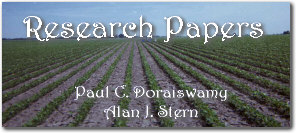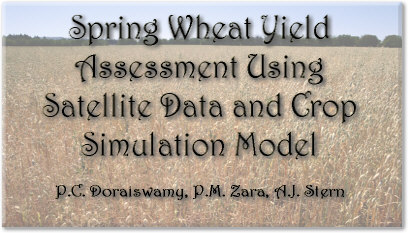| Res11 |

|
 |  | ||||
| |||||
P.C. Doraiswamy, P.M. Zara and A.J. Stern BACKGROUNDAccurate and timely information on crop yields is important because of the economic impact of agricultural production on the world market particularly in the marketing and trading of agricultural commodities. Current procedure (crop cuttings, surveys of farm operators, crop condition report from field offices) is expensive and time consuming. There is a need for a faster and possibly more economical alternative methodology for collecting crop information and yield estimations. Remotely sensed data integrated in a crop simulation model can help in the accurate and timely estimation of crops yields on regional or national level. OBJECTIVETo develop and test procedures for monitoring crop condition and estimating spring wheat yields at the farm and regional levels using satellite data and crop simulation models. APPROACHA schematic diagram of satellite data integration in crop models is shown in figure 1. A radiative transfer model linked the satellite data to the crop model through the LAI. First, LAI output from the crop model was used as input to a radiative transfer model which estimate reflectance in the red and NIR bands of the satellite sensor. From the generated reflectances, NDVI values were calculated and compared with NDVI derived from satellite measurement. If the two NDVI's are significantly different from each other, appropriate parameters in the crop model are adjusted and the model re-ran until a reasonable fit is attained. Study Area The predominantly spring wheat state of North Dakota was selected for this study. About 50% of cultivated land (9.6M acres) in the state is devoted to the production of spring wheat and produces about 50% of the total spring wheat production in the U.S. Crops are genrally grown under non-irrigated condition on loam and clayloam soils with dark to black surfaces. The climate is semi-arid with seasonal rainfall (April to September) ranging from 355 to 457mm. The other principal crops grown are barley, corn, sunflower, and beans. Crop Simulation Model The EPIC model (Williams et al 1984) was used to simulate crop growth and yield. Its components include weather simulation, hydrology, erosion, sedimentation, nutrient cycling, pesticide fate, plant growth, tillage, soil temperature, and crop and soil management. EPIC simulates these processes using a daily time step and generally available input. Radiative transfer model The one dimensional SAIL (Scattering by Arbitrarily Inclined Leaves) model (Verhoef, 1984) was used to simulate canopy reflectance as a function of canopy, soil, illumination and observation angles. Satellite data Landsat TM imagery acquired on two dates (May 28 and June 30, 1994) covering the three southeastern counties were used in the sub-county level assessment. Four NOAA-AVHRR images acquired on May 26, July 2, July 11, July 17, during 1994 growing season were used for the statewide assessment. Ancillary Data Crop information (yield) for the 1994 season were obtained from the North Dakota Agricultural Statistics Annual Report and from the Weekly Crop and Weather Bulliten of the North Dakota Agricultural Statistics Service. Digital soils map of the study area (Fig. 2) was obtained from the State Soil Geographic (STATSGO) data base (NRCS, 1994). Soil physical and chemical properties were obtained from the EPIC's Soils5 data base. Daily weather data were obtained from weather stations (Fig. 3) maintained by the High Plains Climate Center (HPCC, University of Nebraska Lincoln, NE) and National Climate Data Center (NCDC). The weather file contains data on maximum and minimum temperature, precippitation, solar radiation, relative humidity and wind speed. Land Use/Land Cover Classification Land cover map were obtained from the result of two accompanying land cover mapping studies. Detailed land cover map (30m) which covers the southeastern counties of ND for the 1994 crop season was developed by USDA/NASS (Cook et al., 1996) from multi-temporal TM data. This classification of spring wheat was extended to the entire state of North Dakota using NOAA AVHRR data by signature extension techniques (Stern et al.,1996). The Land use map showing class fractions is shown in figure 4. Crop Simulation and Model Calibration Model parameters that affect the size and duration of green leaf area were calibrated, i.e., maximum potential LAI and leaf area decline rate parameters. In addition, since there were no information on actual planting date on individual farms, the planting dates were also adjusted. Statewide Assessment Simulation of crop growth calibrated with remote sensing data were carried for each county using only the dominant soil in the spring wheat growing areas and using weather data from the nearest weather station. Due to mixture of crops in an AVHRR pixels, only the ones with greater than 50% spring wheat content were used in the calibration of the model. County Level Assessment For the sub-county level assessmennt, the TM data was used in the model calibration. Simulation of the crop growth was carried out for each soil association within each county. RESULTS AND DISCUSSIONSCounty and Sub-county Assessment Figure 5 is a map of simulated spring wheat yield distribution in the three southeastern counties. The spring wheat yields varied from 9.2 to 44.8 b/ac, depending on soil properties and seasonal patterns of rainfall. The simulated yields for each soil association were aggregated to obtain the weighted county level yield. A comparison of the simulated and USDA/NASS reported yields are shown in figure 6. There are four yield reports from farmers that are presented along with the county level aggregated yield. Statewide Assessment A comparison of simulated spring wheat yields calibrated with remote sensing data and yields reported by NASS for thirty eight counties which had greater than 50% spring wheat is shown in figure 7. The model simulated the county yields very well except for five counties in the Northeast were there were reports of diseases. The remaining fifteen counties in the state that did not have significant acreage of spring wheat were simulated using model parameters derived from nearby counties and results were combined with the rest of the data. A statewide distribution of county yields is shown in figure 8. SUMMARY AND CONCLUSIONWe have demonstrated the use of a crop simulation model (EPIC) together with remote sensing data (Landsat TM and NOAA-AVHRR) for monitoring crop growth and estimating yields of spring wheat at the county and sub-county level in North Dakota. A radiative transfer model (SAIL) provided the link between satellite data and the crop model. Model simulation calibrated with remotely sensed data obtained during the growing season predicted spring wheat yields with a high degree of accuracy. Remotely sensed satellite data improved crop growth simulations in at least two ways. Firstly, it enables the planting date to be adjusted in order to obtain the correct pattern of crop growth and secondly, it allows model parameters to be adjusted such that the simulated crop growth fit the actual condition. The successful simulation and calibration of crop yields depends on accurate crop classification, availability of cloud-free satellite data during critical periods of growth. | |||||





